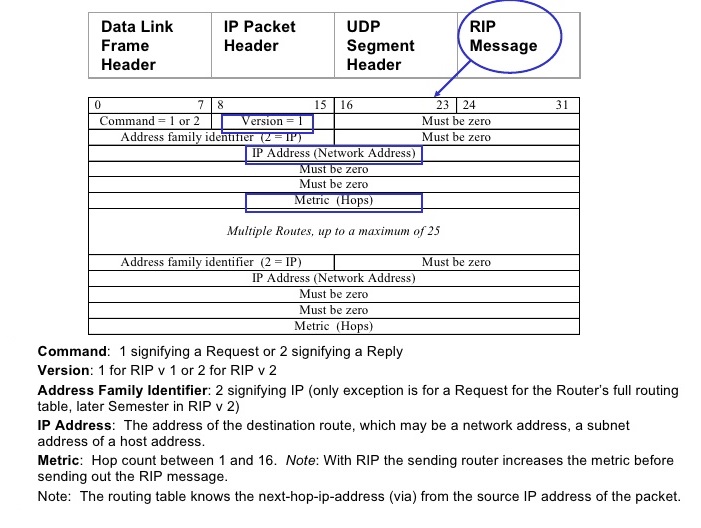Retired Exam
Interior Gateway Protocol (IGP) : A routing protocol that was designed and intended for use inside a single autonomous system (AS)
Known Interior Gateway Protocols (IGP) are Routing Information Protocol (RIP), Interior Gateway Routing Protocol (IGRP), Open Shortest Path First (OSPF) and Intermediate System to Intermediate System (IS-IS)
Exterior Gateway Protocol (EGP) : A routing protocol that was designed and intended for use between different autonomous systems Exterior Gateway Protocol (EGP) is commonly used in the Internet to exchange routing table information. There is only one Exterior Gateway Protocol (EGP) exists and it is Border Gateway Protocol (BGP).
Routing Information Protocol Version 1 (RIPv1) : This is a simple distance vector protocol. It has been enhanced with various techniques, including Split Horizon and Poison Reverse in order to enable it to perform better in somewhat complicated networks.
Features of RIPv1
Routing Information Protocol Version 2 (RIPv2) : RIPv2 is a Hybrid Routing Protocol. A Hybrid Routing Protocol is basically a Distance-Vector protocol which some characteristics of Link State routing protocols.
RIPv2 is classless routing, which allows us to use subnetted networks also. RIPv2 has the option for sending network mask in the update to allow classless routing.
RIP Message
Data link Frame
IP Packet
UDP Segment
RIP Message (Data portion of IP Packet)
RIP Header divided into 3 fields
RIP Header format is as show in the below fig

Features of RIPv2 :
The router rip command selects RIP as the routing protocol. The network command assigns a major network number that the router is directly connected to. The RIP routing process associates interface addresses with the advertised network number and begins RIP packet processing on the specified interfaces.
Runts: This is the number of packets that have been discarded because they are smaller than the medium's minimum packet size. For Ethernet, a packet size of less than 64 bytes is considered a runt.
Giants: This is the number of packets that have been discarded because they exceeded the maximum allowable size of the medium. For Ethernet, a packet size of more than 1518 bytes is considered a giant.
Poison Reverse : When a router advertises a poisoned route to its neighbors,its neighbors break the rule of split horizon and send back to the originator the same poisoned route, with an infinite metric.
LSA's : The packets flooded when a topology change occurs, causing network routers to update their topological databases and recalculate routes
Defining a maximum count : Used for preventing updates from looping the network indefinitely.
Route Poisoning : Advertises an infinite metric for a failed route to all its neighbors
Triggered update : Allows a RIP router to announce route changes almost immediately rather than waiting for the next periodic announcement.
Configuration of Routing Information Protocol version 1 (RIPv1)
The necessary configuration steps for doing the same are as given below:
Step1 : Enter into Global Configuration Mode
R1>enable
R1#configure terminal
Step2 : Enable RIP routing on the router
R1(config)#router rip
Step3: Associate network 1.0.0.0 in the RIP routing process
R1(config-router)#network 1.0.0.0
The command "no router rip" is used for removing all rip entries from the router. Once this is cleared, you must reconfigure RIP again using the "router rip" command.
Example: hostname(config)#router rip
This starts the RIP routing process and places you in router configuration mode
hostname(config)#no router rip
The above command removes the entire RIP configuration you have enabled on the router.
Configuration of Routing Information Protocol version 2 (RIPv2)
The command syntax for configuring RIPv2 on a router is:
router rip
version 2
network <network number>
Example:
router rip
version 2
network 156.14.0.0
network 196.12.12.0
RIP (v1 and v2) and EIGRP are examples of routing protocols that use distance vector. In RIP, the maximum hop count allowed is 15 hops. A hop count of 16 is considered as unreachable. An RIP router determines the path to the destination based on the amount of hops it takes to reach the destination. If it had two different ways to reach the destination, it will simply send the packet via the shortest path (minimum hop count), regardless of the connection speed. This is commonly known as pinhole congestion.
Maximum hop count supported by RIP is 15. A hop count of 16 or greater is considered unreachable. As soon as RIP is enabled, it will start sending and receiving updates on interfaces. Many situations require you to stop RIP from sending updates out an interface. An example of such a situation is when an interface connects to the Internet. You do not want your routing updates to go out to the Internet. In such situations, you can use the passive-interface interface command in the routing configuration mode to stop RIP from sending updates out that interface. This command stop RIP from sending updates but it will continue to receive updates on that interface.
The (config-router)#passive-interface <interface> command stops updates from being sent out an interface, but route updates are still received.
Distance vector protocol depends only on Hop count to determine the nearest next hop for forwarding a packet. One obvious disadvantage is that, if you have a destination connected through two hops via T1 lines, and if the same destination is also connected through a single hop through a 64KBPS line, RIP assumes that the link through 64KBPS is the best path.
Various timers in RIP are given below:
Update-30 sec, Interval between route update advertisements
Hold-Down-90 sec, Period a route is withdrawn from the table to prevent a routing loop.
Timeout-180 sec, Interval a route should stay 'live' in the routing table. This counter is reset every time the router hears an update for this route.
Flush-120 sec, How long to wait to delete a route after it has timed out.
Split horizon : is a method of preventing a routing loop in a network. The basic principle is simple: Information about the routing for a particular packet is never sent back in the direction from which it was received.
Normally, routers that are connected to broadcast-type IP networks and that use distance-vector routing protocols employ the split horizon mechanism to reduce the possibility of routing loops. Split horizon blocks information about routes from being advertised by a router out of any interface from which that information originated. This behavior usually optimizes communications among multiple routers, particularly when links are broken. If an interface is configured with secondary IP addresses and split horizon is enabled, updates might not be sourced by every secondary address. One routing update is sourced per network number unless split horizon is disabled.
To enable or disable split horizon, use the following commands in interface configuration mode, as needed:
Router(config-if)#ip split-horizon - Enables split horizon.
Router(config-if)#no ip split-horizon - Disables split horizon.

